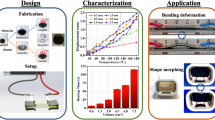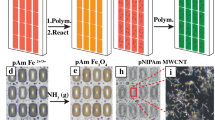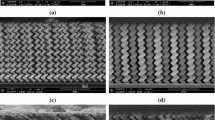Abstact
This paper presents an investigation of the use of electrostrictive silicone polymers as actuators for mesoscale devices. The generated strains of both flat and rolled actuators, based on Dow Corning Sylgard 182 and 184, with sputtered gold electrodes, are presented as functions of the applied electric field. Variables examined in this study include silicone film thickness, gold electrode thickness, cycling of the applied electric field, and actuator configuration (flat or rolled). In general, thinner silicone films and gold electrodes yielded greater strains, at a constant applied field. The actuator performance tended to deteriorate with repeated application of the electric field, and the gold electrodes cracked after being subjected to a large percentage strain.









Similar content being viewed by others
Abbreviations
- A :
-
Cross sectional area, mm2
- a 1 , a 2 :
-
electrostrictive constants, m2/V2
- D :
-
diameter, mm
- E :
-
electric field, V/m
- ε o :
-
permittivity of free space, F/m
- ε :
-
dielectric constant for silicones, F/m
- F :
-
force, N
- J :
-
work, J
- l :
-
length, μm
- S ij :
-
strain tensor, dimensionless
- S ijkl :
-
tensor of elastic compliance coefficients, μm
- t :
-
thickness, μm
- T kl :
-
stress tensor, Pa
- u i :
-
displacement vector, mm
- V :
-
volume, mm3
- ν :
-
Poisson ratio, dimensionless
- w :
-
width, μm
- Y :
-
Young’s modulus, Pa
References
Tabib-Azar M (1998) Microactuators electrical, magnetic, thermal, optical, mechanical, chemical and smart structures. Kluwer Academic, Boston
Pelrine R, Eckerle J, Chiba S (1992) Review of artificial muscles approaches. Third International Symposium on Micro Machine and Human Science Proceedings, Nagoya, Japan
Pelrine R, Kornbluh R, Joseph J, Chiba S (1995) Electrostriction of polymers films for microactuators. Proceedings of Micro-Electro-Mechanical-Systems (MEMS), IEEE, pp 238–243
Pelrine R, Kornbluh RD, Joseph J (1998) Electrostriction of polymer dielectrics with compliant electrodes as a means of actuation. Sensors Actuat A-Phys 64:77–85
Kornbluh R, Pelrine R, Eckerle J, Joseph J (1998) Electrostrictive polymer artificial muscle actuators. Proceedings of the 1998 IEEE International Conference on Robotics & Automation, Leuven, Belgium, pp 2147–2154
Kornbluh R, Pelrine R, Joseph J, Heydt R, Pei Q, Chiba S (1999) High-field electrostriction of elastomeric polymer dielectrics for actuation. SPIE Conference on Electroactive Polymers Actuators and Devices, Newport Beach, CA, pp 149–161
Mujezinovic A (1999) Electrostriction of silicone polymers. MS Thesis, Arizona State University, Department of Mechanical & Aerospace Engineering
Ikeda T (1990) Fundamentals of piezoelectricity. Oxford Science Publications, University Press, Oxford
Krakovsky I, Romijn T, Posthuma de Boer A (1999) A few remarks on the electrostriction of elastomers. J Appl Phys 85:628–629
Acknowledgements
One of the authors (P.E.P.) gratefully acknowledges the support of the National Science Foundation through an NSF CAREER Award (Grant No. CTS-9696003). The authors also wish to thank David Wright for his assistance.
Author information
Authors and Affiliations
Corresponding author
Rights and permissions
About this article
Cite this article
Trujillo, R., Mou, J., Phelan, P.E. et al. Investigation of electrostrictive polymers as actuators for mesoscale devices. Int J Adv Manuf Technol 23, 176–182 (2004). https://doi.org/10.1007/s00170-003-1580-7
Received:
Accepted:
Published:
Issue Date:
DOI: https://doi.org/10.1007/s00170-003-1580-7




